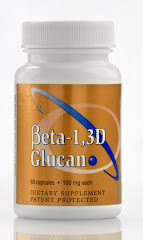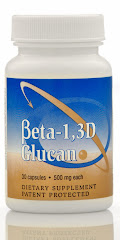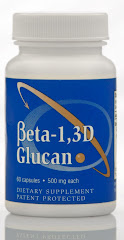Sources of Beta Glucan:
A glucan, is a glucan, is a glucan. Or, Maybe not. by A.J. Lanigan
There is a lot of confusion about beta glucans in the dietary supplement market. Which type is best? What is the correct dosage? What determines purity? Although there is a tremendous amount of scientific research supporting the ability of beta glucans to support healthy immune function, not all beta glucans are alike.
There are differences in molecular structure that affect the biological activity. Some products containing beta glucan are supported by credible research, others are not. Levels of purity, which impacts efficacy and perhaps safety, varies greatly among products.
Beta glucans are homologous polysaccharides that enhances the innate immune system and provide broad protection against a wide range of pathogenic challenges.
There's an extensive amount of research to support this finding. Numerous preclinical studies and more than 60 human clinical studies found in over 800 papers show different improvements in disease models.
A number of compounds share the name "beta glucan" even though they are in fact very different.
Beta glucan can come from yeast, medicinal mushrooms and cereals, such as oats and barley.
Beta glucans have different molecular structures that in turn impact biological activity in the body.
Studies show that yeast beta glucan is superior for supporting and enhancing immune function. Yeast cell walls contain 5 to 10 times the beta glucan contents as compared to medicinal mushrooms, resulting in a product with more active ingredient.
To understand yeast beta glucans and their biological activity, it's important to know where they come from and how they are manufactured.
Outside of the baker's yeast cell is a fibrillar mannoprotein layer that masks and presents a barrier to exposure of the beta 1,3 glucan to the external environment. Beneath the mannoprotein layer are layers of beta glucan and beta glucan chitin, which is outside the plasma membrane. It's this beta glucan layer that actually provides the shape and structural rigidity of the yeast cell. The beta glucan in yeast is analogous to cellulose in a tree. Both provide structural support.
There are a number of products containing beta glucan on the market today. Which is best? What should customers look for?
Here are some things to consider:
1) Look for products that are backed by credible science.
2) Loof for products that are manufactured by those who insist on a certificate of analysis, which clearly shows the actual potency and purity of the product. Evidence of levels of biological activity remove all doubt as to which compound can and will do the job.
3) Patents that prove the product is the genuine article, not a knock-off product.
So what is the Best Beta Glucan for your immune system?
It is Transfer Point Beta-1,3D Glucan from baker's yeast that has the highest purity of carbohydrates and highest concentration of the 1,3 linkage with 1,6 side linkage.
Transfer Point Beta Glucan # 300, Scientifically Proven to be The Ultimate in Beta Glucans
Contact:
Healthful Links
Labels
- 3-D Glucan (1)
- 3D Glucan (1)
- A.J. Lanigan (3)
- aging (1)
- allergies (3)
- Alveolar cells (1)
- Analysis (1)
- Animals (2)
- anthrax research (1)
- anthrax spores (1)
- antibody formation (1)
- antigens (3)
- APC (1)
- ash levels (1)
- athletes (1)
- Auburn University (1)
- Authorized Distributor of Transfer Point Beta Glucan (1)
- autoimmune (1)
- Autoimmune Disease (2)
- B cells (2)
- bakers yeast (8)
- BakersYeastBetaGlucan (5)
- barley (1)
- basophils (1)
- Best Beta Glucan (1)
- Beta Bitts (2)
- Beta Glucan (15)
- Beta Glucan Anti Stress Report (1)
- Beta Glucan Research (1)
- Beta Glucan sources (1)
- beta glucan technology (1)
- Beta Glucan: Nature's Secret (1)
- Biological response modifiers (1)
- bone marrow (2)
- Brain cells and tissue (1)
- brain imaging (1)
- breast cancer (1)
- C3 protein (1)
- cancer (4)
- cancer research (1)
- cardiovascular disease (1)
- cell wall of bakers yeast (1)
- Certificate of Analysis (2)
- chemotaxis (1)
- chemotherapy (2)
- chemotherapy recovery (1)
- Chi Machine (1)
- Cholesterol (1)
- cholesterol research (1)
- Chronic Stress (1)
- Class II MHC molecule (1)
- clinical trials (1)
- Common Cold (1)
- CoQ10 (1)
- corticosterone (1)
- CTLs (1)
- cytokine (5)
- cytotoxic T lymphocytes (1)
- Dosage (2)
- Dr. Jana Vetvickova (1)
- Dr. Vaclav Vetvicka (5)
- Endocytosis (1)
- Enterocytes (1)
- Enterones (1)
- eosenophils (1)
- FIR Dome (1)
- Flu (1)
- Gamma-Interferon (1)
- genetically engineered foods (1)
- Glucan (2)
- Glucan #300 (5)
- Glucan 300 (2)
- Glucan Research (1)
- Glucose molecules (1)
- grains (1)
- HealthIsInReach (1)
- hematopoiesis (1)
- hemotopoeisis (1)
- Homologous polysaccahides (1)
- hospital acquired infections (1)
- Human parainfluenza viruses (1)
- IL-1 (2)
- IL-2 (4)
- illness (1)
- immune cells (1)
- immune modulator (3)
- immune protection (1)
- immune response (5)
- immune stimulating component (1)
- immune supplement (1)
- Immune support (1)
- immune system (11)
- Immune System support (1)
- immuno-modulating properties (1)
- Immunologists (1)
- immunomodulator (1)
- infectious disease (1)
- infectious disease research (1)
- interleukin-1 (1)
- interleukin-2 (1)
- Journal of Medicinal Foods (1)
- Journal of the American Nutraceutical Association (1)
- LDL cholesterol (1)
- Long Chain Polysaccharide (2)
- Lymph nodes (1)
- Lymphatic System (1)
- Lymphoma (1)
- Macromolecules (1)
- macrophages (6)
- Major Histocompatibility Complex (2)
- mediated immune response (1)
- MHC (2)
- MHC I complex (1)
- Microglial cells (1)
- monoclonal antibody (1)
- mushrooms (1)
- myelosupression (1)
- natural alternatives (1)
- Natural Immunomodulators (1)
- natural killer cells (1)
- Neutrophil cells (1)
- neutrophils (2)
- New Book Release (1)
- NK cells (2)
- NPcaps (1)
- NPcaps capsules (1)
- Number one Beta Glucan (1)
- oat (1)
- Open Glycoscience (1)
- oral Beta glucan (1)
- Original Sun Ancon Chi Machine (1)
- patents (3)
- Pet (1)
- PET Scans (1)
- phagocytes (2)
- phagocytosis (4)
- Polysaccharides (1)
- Potency (1)
- Product line (1)
- Professor of Pathology (1)
- protein levels (1)
- Pullulan (1)
- radiation (1)
- radiation protective effect (1)
- radiation recovery (1)
- radiation research (1)
- Resveratrol (1)
- Retroperitoneal Lymph nodes (1)
- Saccharomyces cerevisiae (2)
- seaweed (1)
- Selenium (1)
- stem cells (1)
- stress (2)
- T cells (4)
- Th1 (1)
- Th2 (1)
- TNF (1)
- toxins (1)
- Transfer Point (11)
- Transfer Point Beta Bitts (1)
- Transfer Point Beta Glucan (14)
- Transfer Point Beta Glucan out performs the rest (1)
- Transfer Point Beta Glucan outperforms all other immune supplements tested (1)
- Transfer Point Beta Glucan Purity (2)
- Transfer Point Beta Glucan supplier (1)
- Transfer Point Beta-1 (1)
- tumor (1)
- universities (1)
- University of Louisville (2)
- viruses (1)
- What is Beta 1 (1)
- What is Beta Glucan? (1)
- white blood cells (1)
- Yeast beta glucan (2)
- Yeast cell walls (1)
These statements have not been evaluated by the Food and Drug Administration.
The information provided is not intended to diagnose, treat, cure or prevent any disease.
The information provided is not intended to diagnose, treat, cure or prevent any disease.



